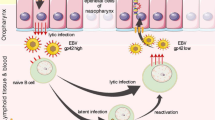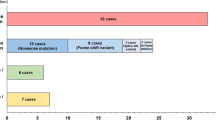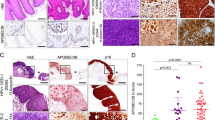Abstract
Undifferentiated nasopharyngeal carcinoma (NPC) is an epithelial malignancy that is consistently associated with Epstein-Barr virus (EBV) but which very rarely has p53 gene mutations in primary tumours. Since the tumour suppressor p53 is mutated in most human cancers or the wild type protein is inactivated in a significant number of the remainder, here we have investigated cellular factors that could compromise p53 function in primary NPC. Twenty-five primary tumours were judged to carry only wild type p53 by SSCP analysis of all exons and sequence determination of exons 4–9. Only one tumour was found to express significant levels of hMdm2 and in 24/25 there were no detectable mutations or deletions in exons 1β and 2 of the p14ARF gene. However, immunohistochemistry consistently revealed that all the tumour cells express substantial amounts of the p53-related protein p63. Semi-quantitative RT–PCR analysis of mRNA from tumour biopsies showed that the dominant species expressed was invariably the truncated ΔN-isotype. Since this can block p53-mediated transactivation, it is potentially a dominant-negative isoform. In normal nasopharyngeal epithelium the distribution of p63 was restricted to the proliferating basal and suprabasal layers. We suggest that ΔN-p63 is a good candidate as a suppressor of wild type p53 function in these tumours and also that it may prove to be a valuable diagnostic marker for undifferentiated NPC.
This is a preview of subscription content, access via your institution
Access options
Subscribe to this journal
Receive 50 print issues and online access
$259.00 per year
only $5.18 per issue
Buy this article
- Purchase on Springer Link
- Instant access to full article PDF
Prices may be subject to local taxes which are calculated during checkout




Similar content being viewed by others
References
Alldred D, Clark G, Elledge R, Fuqua S, Brown R, Chamness G, Osborne G and McGuire W. . 1993 J. Natl. Cancer Inst. 85: 200–206.
Capoulade C, Bressac-de Paillerets B, Lefrere I, Ronsin M, Feuntun J, Tursz T and Wiels J. . 1998 Oncogene 16: 1603–1610.
Effert P, McCoy R, Abdel-Hamid M, Flynn K, Zhang Q, Bussion P, Tursz T, Liu E and Raab-Traub N. . 1992 J. Virol. 66: 3768–3775.
Eischen CM, Weber JD, Roussel MF, Sherr CJ and Cleveland JL. . 1999 Genes Dev. 13: 2658–2669.
Foulkes WD, Flanders TY, Pollock PM and Hayward NK. . 1997 Mol. Med. 3: 5–20.
Fries KL, Miller WE and Raab-Traub N. . 1996 J. Virol. 70: 8653–8659.
Gazzeri S, Gouyer V, Vourch C, Brambilla C and Brambilla E. . 1998 Oncogene 16: 497–504.
Gulley ML, Nicholls JM, Schneider BG, Amin MB, Ro JY and Geradts J. . 1998 Am. J. Pathol. 152: 865–869.
Haupt Y, Maya R, Kazaz A and Oren M. . 1997 Nature 387: 296–299.
Klein G. . 1979 The Epstein-Barr virus. Epstein MA and Achong BG (eds). Springer-Verlag: Berlin.
Kaelin Jr WG. . 1999 Oncogene 18: 7701–7705.
Kaghad M, Bonnet H, Yang A, Creancier L, Biscan J-C, Valent A, Minty A, Chalon P, Lelias J-M, Dumont X, Ferrara P, McKeon F and Caput D. . 1997 Cell 90: 809–819.
Kubbutat MHG, Jones SN and Vousden KH. . 1997 Nature 387: 299–303.
Levine A. . 1997 Cell 88: 323–331.
Lo KW, Cheung ST, Leung SF, van Hasselt A, Mak KF, Chung YF, Woo JK, Lee JC and Huang DP. . 1996 Cancer Res. 56: 2721–2725.
Lo KW, Huang DP and Lau KM. . 1995 Cancer Res. 55: 2039–2043.
Lo KW, Mok CH, Huang DP, Liu YX, Choi PH, Lee JC and Tsao SW. . 1992 Anticancer Res. 12: 1957–1963.
McGregor JM, Berkhout RJ, Rozycka M, Schegget J, Bouwes Bavinck JN, Brooks L and Crook T. . 1997 Oncogene 15: 1737–1740.
Mills AA, Zheng B, Wang X-J, Vogel H, Roop D and Bradley A. . 1999 Nature 398: 708–713.
Murono S, Yoshizaki T, Park CS and Furukawa M. . 1999 Histopathology 34: 432–438.
Niedobitek G, Agathanggelou A, Barber P, Smallman LA, Jones EL and Young LS. . 1993 J. Pathol. 170: 457–461.
Niedobitek G, Agathanggelou A and Nicholls JM. . 1996 Semin. Cancer Biol. 7: 165–174.
Oliner JD, Kinzler KW, Meltzer PS, George D and Vogelstein B. . 1992 Nature 358: 80–83.
Oliner JD, Pietenpol JA, Thiagalingam S, Gyuris J, Kinzler KW and Vogelstein . 1993 Nature 362: 857–860.
Parsa R, Yang A, McKeon F and Green H. . 1999 J. Invest. Dermatol. 113,
Quelle DE, Zindy F, Ashmun R and Sherr CJ. . 1995 Cell 83: 993–1000.
Quelle DE, Cheng M, Ashmun RA and Sherr CJ. . 1997 Proc. Natl. Acad. Sci. USA 94: 3436–3440.
Rickinson A and Kieff E. . 1996 Fields Virology, 3rd edition. Fields BN, Knipe DM, Howley PM et al. (eds).. Lippincott-Raven Publishers: Philadelphia.
Ruas M and Peters G. . 1998 Biochim. Biophys. Acta. 1378: F115–F177.
Sherr CJ. . 1998 Genes Dev. 12: 2984–2991.
Schmitt CA, McCurrach ME, de Stachina E, Wallace-Brodeur RR and Lowe SW. . 1999 Genes Dev. 13: 2670–2677.
Sheu LF, Chen A, Tseng HH, Leu FJ, Lin JK, Ho KC and Meng CL. . 1995 Human Pathol. 26: 380–386.
Spruck CH, Tsai TC, Huang DP, Yang AS, Rideout WM, Gonzalez-Zulueta M, Choi P, Lo KW, Yu MC and Jones PA. . 1992 Cancer Res. 52: 4787–4790.
Stott FJ, Bates S, James MC, McConnell BB, Starborg M, Brookes S, Palmero I, Ryan K, Hara E, Vousden KH and Peters G. . 1998 EMBO J. 17: 5001–5014.
Sun Y, Hegamyer G, Cheng YJ, Hildesheim A, Chen J-Y, Chen I-H, Cao Y, Kai-Tai Y and Colburn NH. . 1992 Proc. Natl. Acad. Sci. USA 89: 6516–6520.
Sun Y, Hilesheim A, Lanier AE, Cao Y, Yao KT, Raab-Traub N and Yang CS. . 1995 Oncogene 10: 785–788.
Vousden KH. . 1993 FASEB J. 7: 872–879.
Yang A, Kaghad M, Wang Y, Gillet E, Flemming MD, Dotsch V, Andrews NC, Caput D and McKeon F. . 1998 Mol. Cell. 2: 305–316.
Yang A, Schweitzer R, Sun D, Kaghad M, Walker N, Bronson RT, Tabin C, Sharpe A, Caput D, Crum C and McKeon F. . 1999 Nature 398: 714–718.
Zhang Y and Xiong Y. . 1999 Mol. Cell. 3: 579–591.
Zhang Y, Xiong Y and Yarborough WG. . 1998 Cell 92: 725–734.
Zindy F, Eischen CM, Randle DH, Kamijo T, Cleveland JL, Sherr CJ and Roussel MF. . 1998 Genes Dev. 12: 2424–2433.
Author information
Authors and Affiliations
Rights and permissions
About this article
Cite this article
Crook, T., Nicholls, J., Brooks, L. et al. High level expression of ΔN-p63: a mechanism for the inactivation of p53 in undifferentiated nasopharyngeal carcinoma (NPC)?. Oncogene 19, 3439–3444 (2000). https://doi.org/10.1038/sj.onc.1203656
Received:
Revised:
Accepted:
Published:
Issue Date:
DOI: https://doi.org/10.1038/sj.onc.1203656
Keywords
This article is cited by
-
TP63 links chromatin remodeling and enhancer reprogramming to epidermal differentiation and squamous cell carcinoma development
Cellular and Molecular Life Sciences (2020)
-
The significance of p40 expression in sclerosing hemangioma of lung
Scientific Reports (2014)
-
ΔNp63 expression in four carcinoma cell lines and the effect on radioresistance—a siRNA knockdown model
Clinical Oral Investigations (2014)
-
Expression profiling of 21 biomolecules in locally advanced nasopharyngeal carcinomas of Caucasian patients
BMC Clinical Pathology (2013)
-
p63 steps into the limelight: crucial roles in the suppression of tumorigenesis and metastasis
Nature Reviews Cancer (2013)



